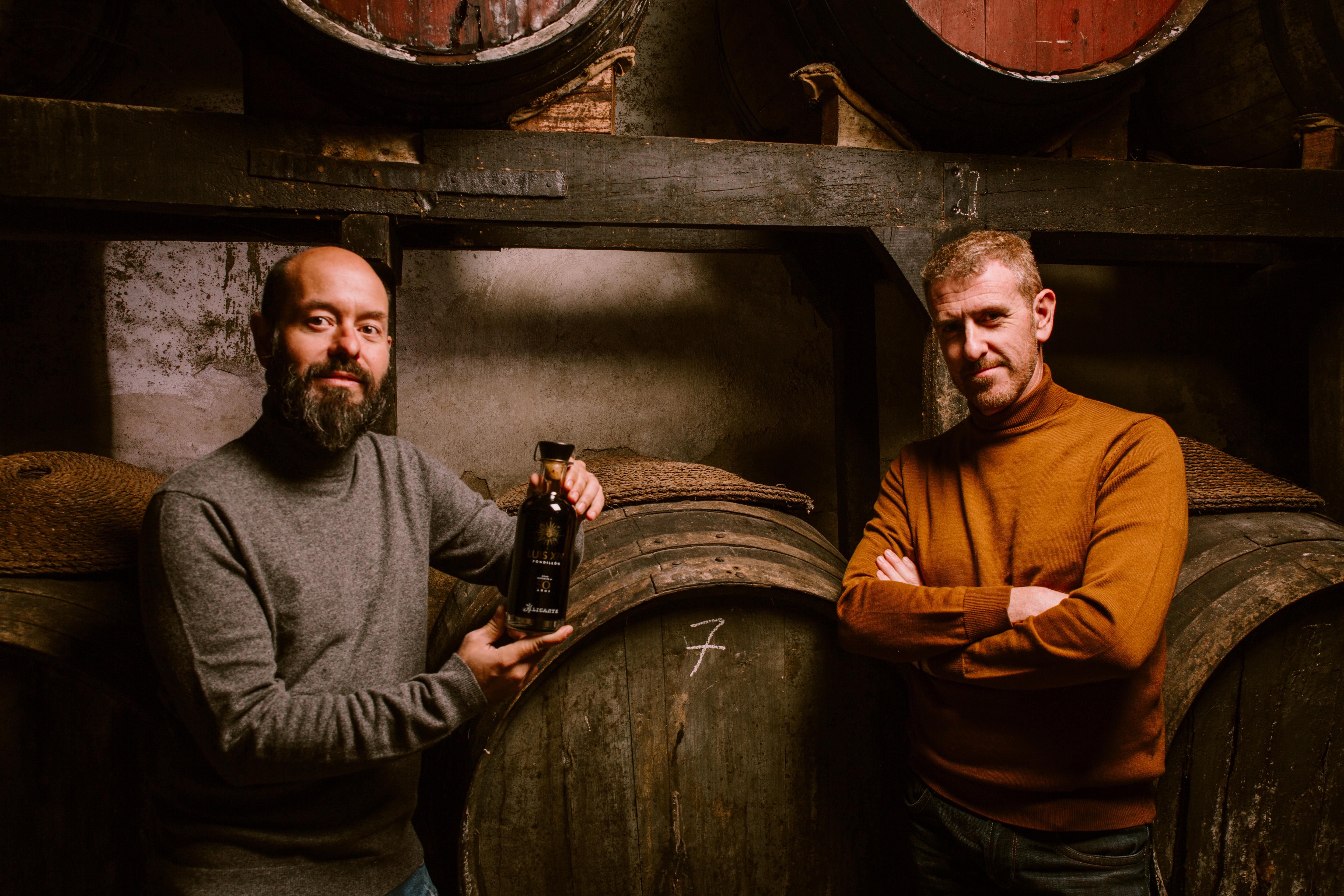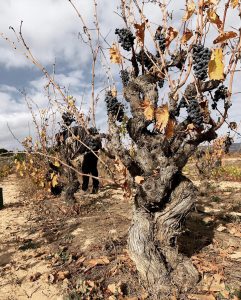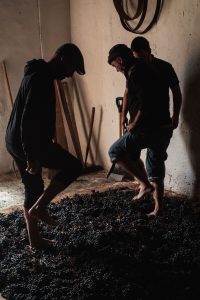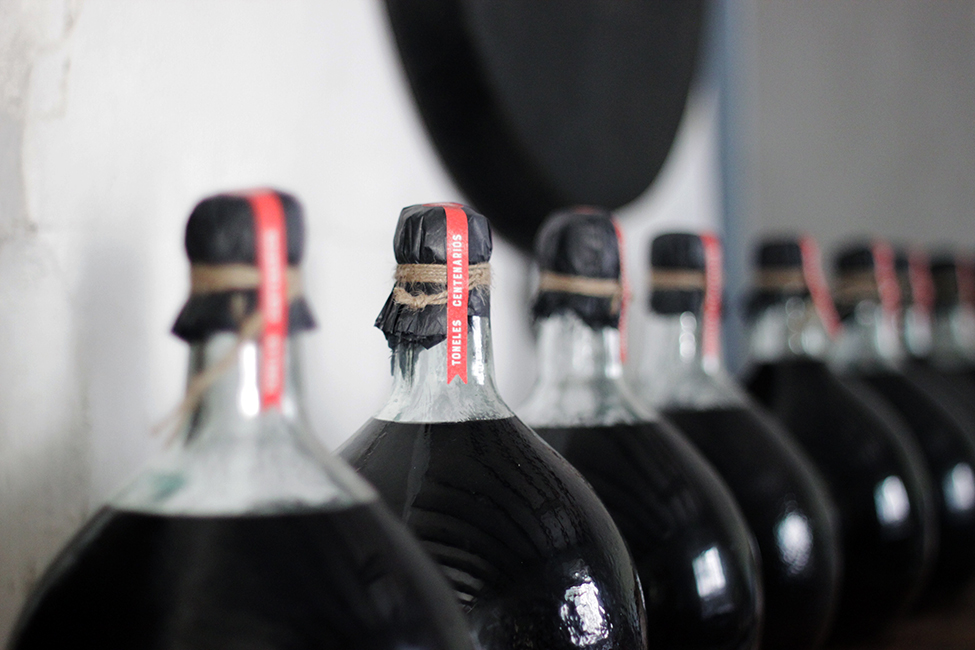
Colección de Toneles Centenarios, Cañada, Alto Vinolopó, Alicante, Spain
The ‘Luis XIV’ Fondillón wines and Vermut are the product of an exciting partnership created by David Carbonell of Vins del Comtat and the current descendants of two, old winemaking families: Ferrero Valdés and Ballester, located in the Alto Vinalopó region of Alicante.
The Colección de Toneles Centarios is a unique and fascinating story originating from a surprise discovery. The partnership came to fruition based on a mutual philosophy to preserve these ‘fondillones’ as an important part of their regional heritage and to breathe new life into the historic tradition of Fondillón wines and winemaking of this Mediterranean region.
In 2015, Ferrero Valdés, a contract grape supplier to Vins del Comtat, asked David to visit an old cellar at their winery, to give them some advice. The cellar, which included an old barrel room, had remained undisturbed since the 1960s. They uncovered a wonderful collection of 25 very old, traditional Fondillón ‘toneles’, still with their contents and in surprisingly good condition.
It is important to understand that retaining the wine in its original barrel is integral to the tradition of Fondillón winemaking and the natural, constant temperature and humidity of the cellar here had created ideal conditions to preserve the casks and the wines they contained.
There was very little documentation or information available to help them identify the actual age of the wines. David and the families worked closely with various experts to ultimately gain classification by the Alicante Consejo Regulador as Fondillón and agree on approved labelling terminology to help denote the age of the wines. Their research included tracing the barrel cooperage markings and using carbon 14 dating on the wood.
This has helped to ascertain the approximate manufacture date of the individual barrels and thereby an estimation of the age of the contents contained within.
 In summary, there are:
In summary, there are:
– 10 barrels ‘toneles’ of 800L, from the end of the 19th century.
– 4 barrels ‘toneles’ of 850L, from the end of the 19th century.
– 11 barrels ‘pipas’ of 500L, from the beginning of the 20th century.
Another branch of the same wine family, Ballester, also joined the partnership. They contributed old wines and barrels, as well as more recent vintages from their own cellar to add to the discovery at Ferrero Valdés. Ballester had continued to make and age Fondillón wines over the years, exclusively for family consumption.
So, in 2018, David and the two families created Colección de Toneles Centenarios’ (CTC), a partnership with the clear objective to preserve and capitalise on their legacy. For them, the priority was to continue the Fondillón tradition for the future as part of the heritage of the region rather than selling off these highly valued barrels to local négociants.
The winemaking tradition of Fondillón – what is Fondillón?
The true nature of Fondillón, requires looking beyond merely ‘old’ and ‘rare’. It is traditionally produced from Monastrell, the classic, predominant red grape grown in the Alicante region (and the 3rd most widely planted red variety in Spain). Fondillones have the distinction of great longevity, capable of extended ageing in solera, protected by a naturally higher level of alcohol, achieved through overripening the grapes on the vine and are never fortified.
The styles can range from off-dry to semi-sweet. They are sometimes identified as ‘rancio’ wines, but the winemaking tradition does not deliberately seek to age the wines oxidatively. A natural element of oxidation does occur over time, through the very extended ageing and natural evaporation. It is traditional, however, to keep the barrels topped up. There is also solera style blending with replacement wines, but in the same barrel (as opposed to the criadera system used in Jerez), to ensure the handling and exposure to air are more limited.
The quality and ageing capacity is reliant on the naturally high alcohol achieved solely from overripe grapes. Not all the wines selected are guaranteed to age well over time and can deteriorate, perhaps having too much volatile acidity or oxidative characters to work well in the solera blends.
The single barrel solera is one of the most distinctive factors in creating Fondillón. The same barrel is usually retained for the whole of its lifetime. They are never fully emptied or cleaned and so there is a slow accumulation of lees in the bottom ‘fondo’. This can sometimes be a substantial amount, up to a third, in a very old barrel and is referred to as the ‘madre ancestrale’. The lees, along with size and age of the barrel, and wood that has been seasoned over many years, pass on the ‘ancestral’ characteristics after they are topped up.
The ‘rare’ nature of Fondillón is also due to the limits on quantity that can be extracted from the solera. Only 20-25% will be extracted for bottling at any one time. The solera then needs to be topped up with another aged Fondillón wine. The frequency will also be very limited, with several years between each ‘saca’. All this contributes to maintaining a very low, annual production. The wines are traditionally labelled as non-vintage but some offer an indication of the year the solera was established.
The past
 Historically, references to ‘Alicante’ wines date back to the 15th century. Alicante’s location on the Mediterranean coast favoured the trading of its ‘robust, sweet wine’ that could withstand the long voyages, without turning to vinegar. The Monastrell grape (Mouvèdre in France), is thought to originate from Spain and is known to be well suited to withstanding hot, dry conditions and able to create concentrated, ripe, full coloured reds.
Historically, references to ‘Alicante’ wines date back to the 15th century. Alicante’s location on the Mediterranean coast favoured the trading of its ‘robust, sweet wine’ that could withstand the long voyages, without turning to vinegar. The Monastrell grape (Mouvèdre in France), is thought to originate from Spain and is known to be well suited to withstanding hot, dry conditions and able to create concentrated, ripe, full coloured reds.
There are many historical references to Alicante as a favourite wine of the rich, royals and elite, most famously that of Louis de Rouvroy, Duc de Saint Simon, official chronicler of the court of Louis XIV. He recorded in the ‘Journal de la maladie du Roi’ in 1715, that Louis XIV on his deathbed would only countenance cakes soaked in Fondillón wine.
The ‘heyday’ of Fondillón was in the 19th Century when the devastation of the French vineyards by Phylloxera resulted in a trade deal secured with Spain to import wines from Alicante, creating a boom in demand. There was a huge increase in vineyard plantings, which also moved inland to include the sub-region of Alto Vinalopó.
Records show the high value placed on bottles of Fondillón and Alexandre Dumas’s novel The Count of Montecristo describes the Count choosing ‘Alicante wine’ over Port and Sherry.
Phylloxera eventually reached Spain and the subsequent recovery had a much-reduced area still cultivated under vine, with many family vineyards and cellars abandoned and production moving more towards cooperatives.
The future
There are now less than 10,000 hectares under vine across the whole of Alicante. Production is mainly of still wines, with a few newer producers starting to revitalise cultivation of the traditional grapes and old vineyards in the region, with some lighter, fresher styles of Monastrell and Moscatel now beginning to appear.
David runs Vins del Comtat in Cocentaina, established in 1997. In addition to their own vineyards (some at 630 metres elevation), they work with contract growers to preserve vineyards and produce wines from the old Monastrell and Moscatel bush vines, as well as more international varieties, such as Cabernet Sauvignon.
Today the ‘last bastion’ of Fondillón, originally found all over Alicante, is the Vinalopó region. Only a limited number of producers have continued the tradition commercially and maintained their own soleras, some of which are extremely old.
There has also been a move to gather old abandoned Fondillón barrels from wineries and family cellars to preserve the barrels and the wines. Today there are only 10 wineries certified by the Alicante Consejo Regulador to officially produce Fondillón. Annual production remains around 5,000 – 8,000 bottles a year.
David states that Colección de Toneles Centenarios is the only producer to recently have received approval for their Fondillón wines. The last ‘new’ producer was approved around 15 years ago. Other wineries have requested, but not achieved certification, which is very strict, and no one is anticipating any more wineries to be admitted in the next few years. The Consejo has established procedures to classify wines recovered from old cellars, as well as define the characteristics and assess the quality of wines destined to be blended in soleras and bottled as Fondillón.
The Alicante Consejo Regulador specify that new wines suitable to eventually enter the solera system must be:
- 100% Monastrell
- have a minimum of 16% natural alcohol (no fortification)
- have a minimum of 4 years of aging in old barrels before adding to a solera
- a maximum of 45g/l residual sugar (no minimum)
For a wine to be bottled and labelled as Fondillón, it must have a minimum of 10 years ageing in old barrels, although all the wines from the Colección de Toneles Centenarios, plus those used for topping up the soleras, well exceed these minimums.
Traditionally most Fondillón are solera, although some are bottled as añada, which means they are only topped up with the same vintage.
Vineyards
The CTC project also has 6 hectares of Monastrell vines in Alto Vinalopó. These  are old bush vines of around 100 years old, with very low yields. The soils are typical of the area a sandy loam and limestone and located at between 550 – 580 metres above sea level.
are old bush vines of around 100 years old, with very low yields. The soils are typical of the area a sandy loam and limestone and located at between 550 – 580 metres above sea level.
Climate
The Mediterranean climate has long summers and low humidity, tempered by a marine influence from easterly winds. The terrain gets drier and much more mountainous as you move inland. The hot days can be tempered by cool nights which help preserve the natural acidity levels in the wines, alongside the higher sugar levels.
Cultivation
A vintage ‘apto para Fondillón’ (suitable for making Fondillón) requires very specific harvest conditions. The Monastrell is noted for its late ripening, smaller berries, thicker skin and capacity to reach high ripeness and potential alcohol levels. The grapes need to be left on the vine to continue to dry out and further intensify their potential alcohol levels. This requires a long, dry autumn with enough sunshine to ensure there is no rot. Producers are looking for a raisin character in the grapes, but not botrytis. The bunches need to be ‘clean’ and are selected on numerous passes through the vineyard. The regional climate conditions tend to support healthy conditions for the grapes.
enough sunshine to ensure there is no rot. Producers are looking for a raisin character in the grapes, but not botrytis. The bunches need to be ‘clean’ and are selected on numerous passes through the vineyard. The regional climate conditions tend to support healthy conditions for the grapes.
The 2020 harvest, the first ‘apto de Fondillón’ for the continuation of the CTC project, was on 4th November, with the grapes having a potential alcohol of 17.5%.
Winemaking
Starting from the 2020 vintage, CTC were offered the use of ‘El Pinaret’ – a small, old, family winery in Cañada, belonging to Regino Ballester. The grapes were foot trodden on planks over the traditional style, concrete lined lagar, which helps to regulate the temperature and maintain the slow, very extended fermentation. This allows the yeast to survive long enough for the wine to reach the minimum 16% alcohol and not be overwhelmed by the remaining sugar and rising alcohol content.
The Wines
The Colección de Toneles Centenarios partnership has worked closely with the Alicante Consejo Regulador to ensure their wines are certified. The first bottlings have been approved for labelling as ‘age superior to 25 years old’ and ‘age superior to 50 years old’, confirming that is the minimum age of the wines.
Their intention is to bottle fondillones once a year from different casks. They will be drawing on much older wines from their cellars; more than the 4 year old minimum requirement, to top up. They also want to continue creating wines, suitable for extended ageing, from their old vineyards which were originally used in the past to make Fondillón.
The aim is to continue ageing newer vintages for as long as possible and to build up replacement stocks of the right quality for blending, using the traditional solera method, according to the Fondillón tradition.
Luis XIV 25 Fondillón 50cl (17% alc. RS 45g/l VA 1.05g/l)
DOP Alicante ‘Edad superior a 25 años’
Bottled May 2020
Total 750 bottles
100% Monastrell
The 25 year old is a blend of 2 different soleras aged in 19th century American oak. A ‘saca’ was taken from each of the casks 805L 70 cántaros valencianos and 600L pipas and blended. The original casks are topped up individually with another wine at least 10 years old and will not have another saca for another 10 years. A different two will be selected for the next saca and bottling.
Luis XIV 50 Fondillón 50cl (16% alc. RS 34g/l VA 1.35g/l)
DOP Alicante ‘Edad superior a 50 años’
Bottled December 2019
Total 435 numbered bottles individual wooden case
100% Monastrell
The 50 year old is single barrel 805L 70 cántaros valencianos solera, aged in 19th century American oak. Each bottle has a handwritten label, with an individual number, the barrel name ‘Saboners’ and bottling date.
This cask has since been topped with another Fondillón, of at least 25 years old, and will be left for a minimum of 10 years before any further wine is extracted. The slightly odd barrel 805L barrels size is called ‘70 cántaros valencianos’ as this refers to an old-fashioned measure jug or pitcher measure of 11.5 litres. So, 70 x 11.5 litres is equal to 805 litres…
Luis XIV Vermut Rojo Dulce 75cl (15% alc. RS 100g/l)
70% Macabeo 30% Monastrell
Vermut was also a traditional drink in the Mediterranean region and recently seen a revival of interest in Spain and internationally.
The collaboration hit on the idea of experimenting with creating a Vermut, which could also gain some distinctive characteristics from ageing in very old Fondillón barrels. They also saw the potential for adding some old Monastrell from the cellars to the blend. This was a potential use for those wines which were not suitable for the extended ageing required for high quality Fondillón.
After some very good responses, it was decided to create this distinctive new brand of Vermut under the Luis XIV label, with its origins in the traditions and heritage of the region.
 The young Vermut is created from Macabeo which is fermented and then infused with a selection of botanicals and fortified to 15%. The botanicals used are the classic ingredient wormwood, plus their own selection which includes cinnamon, cloves, vanilla and orange peel. This is blended with 30% 8 year old, oxidised Monastrell from the old cellars and aged for two months using the ancient Fondillón barrels.
The young Vermut is created from Macabeo which is fermented and then infused with a selection of botanicals and fortified to 15%. The botanicals used are the classic ingredient wormwood, plus their own selection which includes cinnamon, cloves, vanilla and orange peel. This is blended with 30% 8 year old, oxidised Monastrell from the old cellars and aged for two months using the ancient Fondillón barrels.
The Monastrell helps creates a pale garnet hue, which is entirely natural, with nothing further added to deepen the colour. The final combination is a Vermut Rojo Dulce which reflects the ‘richer’ Mediterranean style. Some of the finished Vermut is stored in the wonderfully bulbous glass traditional ‘damajuanas’.
The Luis XIV Vermut Rojo also has a quirky style bottle, which David choose as it is reminiscent of styles used in the 1980s. It is something of a party piece, since the white lettering takes on a luminescent glow in the dark…. More importantly though, the warm spicey flavours which work particularly well with the addition of crushed ice and a swirl of orange peel, have their own star quality.
www.fondillonluisxiv.com
| Luis XIV 25 Fondillón | pack shot | fiche |
| Luis XIV 50 Fondillón | pack shot pack shot with wooden case |
fiche |
| Luis XIV Vermut Rojo | pack shot | fiche |